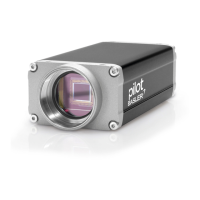Features
Basler pilot 157
Shift by 2
When the camera is set to shift by 2, the output
from the camera will include bit 9 through bit 0
from each ADC along with 2 zeros as LSBs.
The result of shifting twice is that the output of
the camera is effectively multiplied by 4.
When the camera is set to shift by 2, the 2 least
significant bits output from the camera for each
pixel value will be 0. This means that the gray
value scale will only include every 4th gray
value, for example, 4, 8, 16, 20, and so on.
If the pixel values being output by the camera’s sensor are high enough to set bit 10 or bit 11 to 1,
we recommend not using shift by 2. If you do nonetheless, all bits output from the camera will
automatically be set to 1. Therefore, you should only use the shift by 2 setting when your pixel
readings with a 12 bit pixel format selected and with digital shift disabled are all less than 1024.
Shift By 3
When the camera is set to shift by 3, the
output from the camera will include bit 8
through bit 0 from each ADC along with 3
zeros as LSBs.
The result of shifting 3 times is that the
output of the camera is effectively multiplied
by 8.
When the camera is set to shift by 3, the 3
least significant bits output from the camera
for each pixel value will be 0. This means that the gray value scale will only include every 8th gray
value, for example, 8, 16, 24, 32, and so on.
If the pixel values being output by the camera’s sensor are high enough to set bit 9, bit 10, or bit 11
to 1, we recommend not using shift by 3. If you do nonetheless, all bits output from the camera will
automatically be set to 1. Therefore, you should only use the shift by 3 setting when your pixel
readings with a 12 bit pixel format selected and with digital shift disabled are all less than 512.
Shift By 4
When the camera is set to shift by 4, the
output from the camera will include bit 7
through bit 0 from each ADC along with 4
zeros as LSBs.
The result of shifting 4 times is that the
output of the camera is effectively
multiplied by 16.

